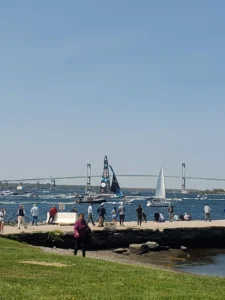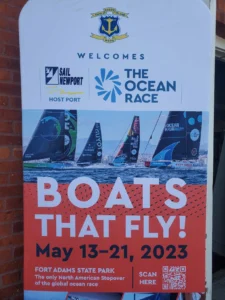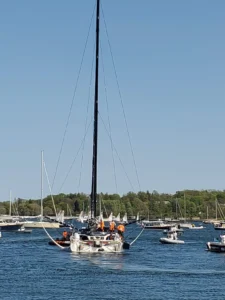Ocean Race: A great adventure around the world
What is the Ocean Race?
The Ocean Race is a sailing race around the world. The Ocean Race 2023 is the 14th edition of the race, covers approximately 38,000 nautical miles and takes the teams to some of the most challenging and remote locations on the planet.
What are the 7 legs for the 2023 edition:
-
Leg 1: Start in Alicante, Spain to Cape Verde
-
Leg 2: Cape Verde to Cape Town
-
Leg 3: Cape Town to Itajai
-
Leg 4: Itajai to Newport
-
Leg 5: Newport to Aarhus
-
Leg 6: Kiel to The Hague
-
Leg 7: The Hague to Genova for grand finale
The Ocean Race is known for its intense competition, as teams from around the world compete to be the first to complete the grueling race. The race features a mix of professional and amateur sailors, and it is widely regarded as one of the toughest endurance challenges in the world.
In addition to the competitive aspect of the race, The Ocean Race also focuses on sustainability and environmental protection. The race has made a commitment to reduce its environmental impact, and it works closely with sustainability partners to promote environmental awareness and action.




What are IMOCA sail boats?
The Ocean Race sailboats are in the IMOCA class.
IMOCA (International Monohull Open Class Association) boats are high-performance sailing yachts designed specifically for single-handed or double-handed ocean racing. They are used in some of the world’s most prestigious offshore races, including The Ocean Race, Vendée Globe, and Route du Rhum. IMOCA boats are built to be fast, lightweight, and durable, with a focus on performance and safety. They are typically between 60 and 75 feet long, with a narrow beam and a deep draft. The boats are designed to be sailed by a crew of one or two, with a minimal amount of on-deck equipment to reduce weight and increase speed.
The IMOCA used for the Ocean Race are 60 feet long and crewed by four sailors.
One of the defining features of IMOCA boats is their cutting-edge technology. The boats are equipped with the latest navigation, communication, and safety equipment, including satellite communication systems, GPS navigation, and advanced weather forecasting tools. They also have advanced sail handling systems, including hydraulic winches and automated sail controls. In recent years, IMOCA boats have become increasingly popular in offshore racing due to their speed and versatility. They are capable of sailing at high speeds in all types of conditions, from calm waters to rough seas, making them a favorite among professional sailors and ocean racers.
The 5 participants to the Ocean Race:
-
11th hour racing team – USA – Skipper: Charlie Enright
-
Team Malizia – Germany – Skipper: Boris Herrman
-
Guyot Environnment – Team Europe – Skipper: Benjamin Dutreux and Robert Stanjeck
-
Biotherm – France – Paul Meilhat
-
Team Holcim – PRB – Switzerland – Kevin Escoffier
A short history of the Ocean Race:
The Ocean Race, formerly known as the Whitbread Round the World Race, is one of the oldest and most prestigious offshore sailing races in the world. Here’s a brief overview of the race’s history and its different names:
The Whitbread: A sailing race around the world
The race was first held in 1973-74 as the Whitbread Round the World Race. The race was created by the Whitbread brewing company as a way to promote its brand and to challenge the world’s top sailors to compete in a grueling around-the-world race. The first race started in Portsmouth, England, and took the competitors on a 32,000-mile journey around the world, stopping at several ports along the way. The race was won by the British yacht Sayula II, skippered by Ramón Carlin.
Over the years, the race grew in popularity, with more and more teams competing from around the world. The race continued to be known as the Whitbread Round the World Race until 1997, when it was renamed The Volvo Ocean Race, after the car manufacturer Volvo became the race’s title sponsor.
The Volvo Ocean Race:
The Volvo Ocean Race continued to be held every three years, with teams competing in various classes of boats. The race became known for its intense competition, as well as for its grueling conditions and challenging weather. In 2018, the race was renamed The Ocean Race, after Volvo ended its sponsorship. The race continued to attract top sailing teams from around the world, with competitors sailing in the high-performance IMOCA 60 class boats.
Throughout its history, The Ocean Race has been a test of skill, endurance, and determination for the world’s top sailors, and it remains one of the most challenging and prestigious offshore sailing races in the world.
The Winners of the Ocean Race since 1974:
Here’s a list of the winning skippers of The Ocean Race since its inception as the Whitbread in 1973-74:
-
1973-74: Ramen Carlin (Sayula II, Mexico)
-
1977-78: Conny van Rietschoten (Flyer, Netherlands)
-
1981-82: Conny van Rietschoten (Flyer, Netherlands)
-
1985-86: Peter Blake (Rothmans, New Zealand)
-
1989-90: Peter Blake (Steinlager 2, New Zealand)
-
1993-94: Chris Dickson (Tokio, Japan)
-
1997-98: Grant Dalton (Merit Cup, Switzerland)
-
2001-02: John Kostecki (illbruck Challenge, Germany)
-
2005-06: Mike Sanderson (ABN AMRO ONE, Netherlands)
-
2008-09: Torben Grael (Ericsson 4, Sweden)
-
2011-12: Franck Cammas (Groupama 4, France)
-
2014-15: Ian Walker (Abu Dhabi Ocean Racing, UAE)
-
2017-18: Charles Caudrelier (Dongfeng Race Team, China)
The Race Villages of the host cities
During the ocean race, each host city sets up a Race Village, which serves as the hub of activity for the event. Here’s a brief description of what visitors can expect at a typical Race Village:
-
Interactive exhibits: Race Villages feature interactive exhibits and displays that allow visitors to learn about the history of the race, the participating teams and sailors, and the technology behind the boats. Visitors can also take part in simulations and games that give them a taste of what it’s like to sail in the race.
-
Entertainment: Race Villages are often home to live music, cultural performances, and other forms of entertainment. The atmosphere is festive, with food and drinks available from vendors and local restaurants.
-
Team bases: Each team participating in the race has its own base in the Race Village, where visitors can meet the sailors, see the boats up close, and learn more about the team’s strategy and preparation for the race.
-
Fan experiences: Fans can get up close and personal with the boats and equipment used in the race, take guided tours of the team bases, and even go out on the water in spectator boats to watch the race.
-
Sustainable initiatives: As part of The Ocean Race’s commitment to sustainability, Race Villages often feature exhibits and initiatives that highlight environmental issues and promote sustainable practices.
Overall, a visit to a Race Village is a great way to experience the excitement and energy of The Ocean Race, meet sailors and teams from around the world, and learn about the sport of sailing and its global impact.
Related articles: